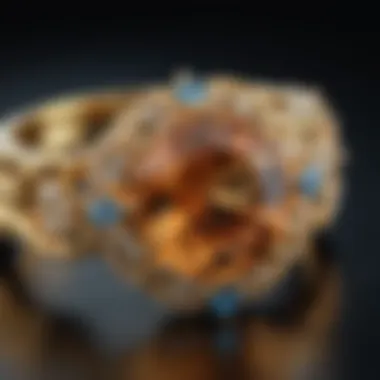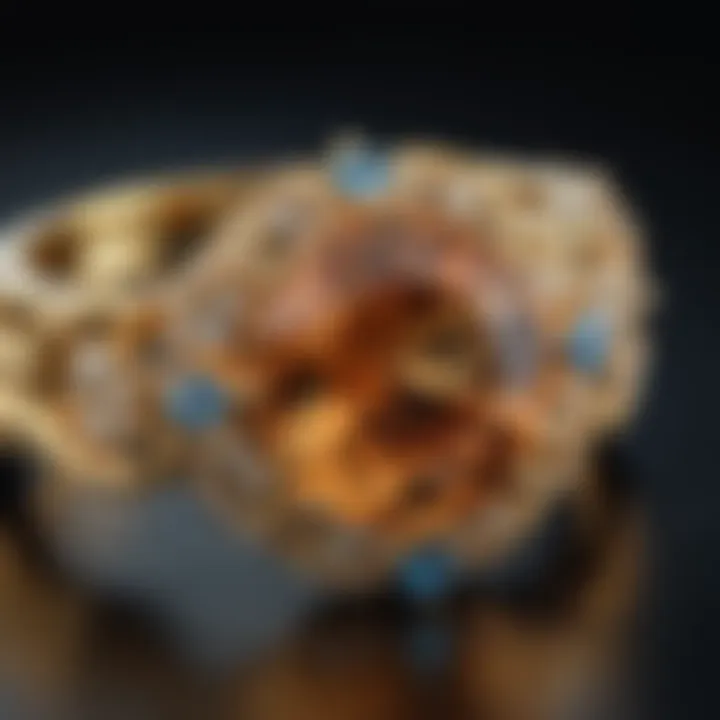The Significance and Characteristics of Topaz


Intro
Topaz, a gem with captivating hues and intriguing history, holds a significant place in the world of gemstones. This article aims to shed light on its characteristics, cultural relevance, and practical considerations for enthusiasts and collectors alike. From the sparkling brilliance of its various colors to the geological phenomena that lead to its formation, topaz serves not only as an aesthetic adornment but also as a symbol of personal significance for many.
Understanding topaz is essential, especially for those born in November, as it is their designated birthstone. The allure of topaz extends beyond its visual appeal and into the realms of metaphysical properties and symbolic meanings. This guide endeavors to cover all facets of topaz in a structured manner, making it an invaluable resource for both novices and seasoned collectors.
Overview of Gemstones and Minerals
The study of gemstones and minerals unfolds a rich narrative of natural beauty and human fascination. Gemstones have been a source of allure throughout history, often signifying wealth, power, and cultural heritage. This section explores the historical significance and societal roles of gemstones, outlining their journey through time.
History of Gemstone and Mineral Use
Throughout the ages, gemstones have found their place in human culture. Ancient civilizations revered them for their beauty and rarity. The Egyptians, for instance, believed that stones like turquoise and lapis lazuli harbored divine powers. Birthstones, including topaz, often aligned with astrological and spiritual beliefs, giving them deeper significance.
Significance in Culture and Society
In many cultures, gemstones carry substantial meaning, being seen as tokens of protection, love, and prosperity. Topaz, recognized for its associations with loyalty and strength, is often a gift symbolizing deep bonds. This cultural importance persists today, as more people seek to connect emotionally with their birthstones.
Gemstone Formation and Properties
Understanding how gemstones, specifically topaz, form is fundamental to appreciating their value and uniqueness. This section delves into both the formation processes and the essential properties that define topaz.
Formation Process of Gemstones
Gemstones like topaz originate from geological processes that take place over millions of years. They form primarily in igneous rocks through crystallization from magma or hydrothermal solutions. The unique chemical composition of topaz includes aluminum, silicon, and fluorine, which contribute to its varied colors.
Properties that Define Gemstones
Topaz exhibits several noteworthy properties, including:
- Hardness: Topaz ranks 8 on the Mohs scale.
- Luster: It displays a vitreous sheen.
- Refractive Index: Ranges between 1.609 - 1.630, affecting how light passes through it.
These characteristics contribute not only to its visual appeal but also its durability as a gemstone in jewelry.
Classification based on Color, Hardness, and Luster
Topaz is often classified by color, which ranges from clear and colorless to rich shades of blue, yellow, and orange. Each color can carry different meanings and attract varied buyers. This variety enhances topaz's allure in the gemstone market.
Types of Gemstones
Not all gemstones are created equal. This section examines the categories within which topaz and other gemstones fall.
Precious vs. Semi-Precious Gemstones
Traditionally, gemstones are categorized as precious or semi-precious. Precious stones include diamonds, rubies, sapphires, and emeralds, while topaz is typically classified as semi-precious. However, its stunning colors and exceptional qualities have elevated its status in the eyes of consumers and collectors.
Common Gemstone Varieties
Topaz itself comes in many varieties, including:
- Imperial Topaz: Known for its warm golden hues.
- Blue Topaz: Gaining popularity for its appealing shade.
- Mystic Topaz: Features a unique iridescent quality.
Exotic and Rare Gemstones
While topaz is widely available, other gemstones are rarer, often carrying a higher price point. Collectors may seek out rare samples for their uniqueness and investment potential.
Identifying and Evaluating Gemstones
Determining the quality and authenticity of gemstones is crucial, especially in valuable markets.
Factors Affecting Gemstone Value
Several factors influence the value of topaz:
- Color Quality: Rich, vibrant colors are most desirable.
- Clarity: Fewer inclusions or blemishes can enhance value.
- Cut: The craftsmanship in cutting impacts brilliance and overall aesthetics.
Techniques for Gemstone Identification
Identifying topaz involves several methods, such as:
- Visual Inspection: Checking for color saturation and clarity.
- Refractive Index Testing: Comparing against known values for topaz.


Assessing Gemstone Quality
Evaluating the quality of topaz enables buyers to make informed decisions. Engaging with qualified gemologists can provide assurance of authenticity and quality, guiding purchases effectively.
Caring for Gemstones
Once acquired, maintaining gemstones like topaz is vital for their longevity and appearance.
Cleaning and Storing Gemstones Properly
To keep topaz vibrant, clean it using a mild detergent and lukewarm water. Avoid harsh chemicals. Store topaz separately to prevent scratches from harder stones.
Avoiding Common Mistakes in Gemstone Care
Many occur through neglect. Key mistakes include exposure to extreme temperatures or leaving them unprotected. Taking simple precautions can prolong the life of topaz.
Preservation Tips for Specific Gem Types
Special care may be required based on topaz type, particularly for treated stones. Understanding these nuances helps protect your investment and maintains the stone's aesthetic beauty.
Preamble to Topaz as a Birthstone
Topaz holds a significant place in the world of gemstones, especially as a birthstone for November. Understanding its importance is essential for both aficionados and those curious about gemstones. Topaz is much more than a mere ornament; it encapsulates various cultural meanings, historical narratives, and practical insights about the stone's usage and value.
Overview of Birthstones
Birthstones have long been part of various cultures, creating a bridge between individuals and their personal attributes. Each month has a specific stone believed to bring good fortune, protection, and healing properties to those born in that month. This tradition dates back to ancient civilizations, linking gemstones to spirituality and personal identity.
Topaz, designated for November, is associated with serenity and calmness. The stone is thought to offer emotional balance and enhance one's creativity. Various cultures have attributed different meanings to topaz over time, reinforcing its significance in personal and broader social contexts.
When selecting a gemstone, birthstones serve as a thoughtful choice, symbolizing personal traits and qualities relevant to one's birth month. This allows each stone, including topaz, to tell a unique story beyond its physical beauty.
Topaz: The November Birthstone
Topaz comes in a variety of colors, adding diversity to its appeal as the November birthstone. Historically, it has been valued for its brilliance and clarity. It symbolizes love and affection. Furthermore, it has been believed to promote health, wealth, and knowledge for its wearers. The association of topaz with November adds a layer of significance, enriching its narrative as more than a mere decorative piece.
Individuals born in November often resonate with the traits linked to topaz. These may include intelligence, honesty, and compassion. Choosing topaz as a birthstone is a way to celebrate these characteristics.
Topaz also features heavily in contemporary jewelry design, often serving as the focal point in various settings. Its presence in both everyday and special occasion jewelry underscores how deeply individuals connect with their birthstone. As a November birthstone, topaz represents empowerment and personal growth.
In summary, topaz embodies not only beauty and elegance but also a rich mosaic of meanings and cultural significance. Its status as a birthstone offers a compelling perspective, inviting deeper appreciation and understanding.
Color Varieties of Topaz
The color varieties of topaz are significant in understanding the gem's allure and cultural relevance. Topaz is not just the November birthstone; its diverse color spectrum allows for personalization and deeper meanings. This section will focus on the natural color range and common treatments used to enhance these colors. Each variety is unique and carries its own charm.
Natural Color Spectrum
Topaz exists in a variety of colors, which are influenced by the presence of certain elements and natural geological processes. The most recognized hue is the yellow to golden shades, often associated with warmth and positivity. However, topaz can also showcase colors such as blue, pink, and clear, among others.
- Blue Topaz: This variety can range from a light, sky blue to a deep, oceanic blue. Naturally blue topaz is rare; most available in the market have been treated to achieve their color.
- Imperial Topaz: Known for its warm, orange to pink tones, imperial topaz is one of the most prized varieties. This color is often linked to wealth and luxury due to its rarity.
- Clear Topaz: This variety resembles a diamond and is used in various jewelry settings. Its clarity allows for effective light refraction, enhancing the gem's brilliance.
- Mystic Topaz: This is not a naturally occurring color but rather a treated one. The gem undergoes a process that gives it a rainbow-like appearance, making it popular among jewelry designers.
"The beauty of topaz is not only in its clarity but also in its vibrant, shifting colors that capture a wide range of emotions and meanings."
Understanding these colors enhances appreciation for topaz in jewelry and its significance across cultures. Each hue tells a story, making topaz not just a physical gem but a piece imbued with meaning.
Common Treatments for Color Enhancement
Natural topaz often undergoes treatments to enhance its color and overall appeal. While these treatments can improve the gem's attractiveness, some collectors prefer stones in their natural state. Here are the most common treatments:
- Irradiation: This process involves exposing topaz to radiation to produce blue hues. The treatment can result in vibrant, uniform colors that are appealing to buyers.
- Heat Treatment: Heating topaz alters its color temporarily or permanently. For example, a heat treatment can transform brown topaz into golden yellow or even blue shades.
- Coating: Some topaz stones are coated with a thin layer of other materials to create dramatic colors like mystic topaz. This treatment is often used to enhance the visual appeal of the stone but may require careful handling.
Understanding these treatments is essential for anyone interested in buying or collecting topaz. It affects not only the stone's pricing but also its perceived value and authenticity.
Historical Context of Topaz
The historical context of topaz provides insight into how this gemstone has shaped cultures, beliefs, and artistic expression through the ages. The significance of topaz extends beyond its physical properties; it carries rich narratives and meanings that have evolved over centuries. Understanding these historical aspects allows individuals to appreciate not only the beauty of topaz but also its role in human history.
Ancient Beliefs and Myths
Topaz has been revered since ancient times. Different cultures attributed various meanings and powers to this gemstone. For instance, in ancient Egypt, topaz was believed to be a stone of protection. It was said that this gem could guard against harm, especially from night terrors and evil spirits. The Egyptians associated yellow topaz with the sun god, Ra, believing that it was infused with divine power.
In Greco-Roman traditions, topaz was similarly valued. The Romans introduced several myths surrounding the gem. They believed that wearing topaz could enhance strength and provide clarity of thought. Some even claimed that it could improve eyesight. It became a stone of wisdom, often linked with philosophers and leaders who sought clarity in their decisions.


"Topaz was considered a symbol of friendship and loyalty in the ancient world."
As time progressed, topaz found its significance in various religious texts and traditions, often symbolizing divine love and compassion. It remained a popular choice among royalty and elites, who regarded it as a status symbol. The gemstone’s versatility added to its allure, leading to its use in jewelry across different civilizations.
Topaz in Art and Culture
Topaz has played a vital role in the arts and culture throughout history. Notably, during the Renaissance, this gemstone became fashionable among nobility and artists alike. Many renowned painters from this era incorporated topaz motifs into their artwork, illustrating its beauty. Additionally, topaz was often used in elaborate jewelry pieces often worn by queens and princesses.
In literature, topaz has inspired numerous references in poetry and prose. Writers showcased it as a symbol of luxury and elegance. The gem represents strength in various written works, reflecting the duality of fragility and resilience.
In various cultures, topaz features prominently in folklore and traditions. Many native tribes in America have harnessed the stone's energy for healing and protection. In contrasting fashion, Asian cultures regard it as a beacon of good fortune, often gifting topaz to loved ones to signify loyalty and prosperity.
Today, topaz continues to evoke admiration in modern jewelry design. As a result, designers frequently draw inspiration from both its storied past and its vibrant color variations. This deep connection between topaz and its historical roots further enriches our understanding and appreciation of this captivating gemstone.
Geological Origins of Topaz
Understanding the geological origins of topaz is crucial for several reasons. First, it provides insight into how this remarkable gemstone forms, revealing the intricate processes involved. This knowledge is essential for gemstone enthusiasts and collectors who seek to appreciate topaz in both its natural state and in jewelry. Additionally, knowing the origins may also contribute to an appreciation for the rarity and uniqueness of individual stones.
Formation Processes
Topaz is formed in igneous rocks, particularly in granitic environments. The process begins when magma cools slowly beneath the Earth's surface. As the magma solidifies, elements like aluminum and fluorine combine with silicate minerals to form topaz. This mineral is part of the orthorhombic crystal system, exhibiting a variety of colors and often exhibiting transparency and clarity.
Moreover, the existence of certain geochemical conditions is necessary for topaz to crystallize. High temperatures and specific pressures lead to the formation of topaz-rich veins. In some scenarios, topaz may occur in pegmatitic formations, where minerals grow slowly, allowing large crystal structures to develop. Each geological nuance affects the color and clarity of the resulting gemstones.
Sources of Topaz Worldwide
Topaz can be found in various global locations, contributing to its diverse characteristics. Significant sources include:
- Brazil: Known for its vibrant imperial topaz, which is yellowish-orange in color. Brazil has long been a dominant player in the topaz market.
- Russia: The Ural Mountains are renowned for producing large, clear crystals, often in light blue or yellow shades.
- United States: In the U.S., topaz is notably sourced from Texas and Utah, where some unique color variations can be discovered.
- Pakistan: This region yields exceptional examples of high-quality blue topaz, prized for its brilliance.
- Sri Lanka: Known for a range of topaz colors, Sri Lanka adds to the gemstone's global tapestry.
The Value of Topaz
The value of topaz goes beyond its monetary worth. For gemstone enthusiasts, collectors, and jewelry designers, understanding what influences topaz pricing is essential. Topaz, a mineral known for its diverse color palette and clarity, holds a significant place in both the gemstone market and cultural expressions. Buyers often seek out topaz for its healing properties, aesthetic qualities, and astrological associations. Therefore, evaluating the true value of this gem requires consideration of various factors, including its color, quality, and the prevailing market dynamics.
Factors Influencing Topaz Pricing
Several criteria determine the price tags attached to topaz stones. Below are critical factors to keep in mind:
- Color: The most desired topaz colors are often the vivid blue and rich golden hues. Blue topaz, particularly the Swiss Blue and London Blue varieties, can fetch higher prices due to their popularity. Additionally, the intensity of the color and absence of zoning can impact value.
- Clarity: Clarity directly affects the pricing of topaz. Clear stones without visible inclusions are more valuable. However, some collectors might find unique inclusions appealing, affecting market value differently based on current trends.
- Cut: The cut of the gemstone plays a crucial role in its brilliance and overall appeal. A well-cut stone maximizes light reflection, enhancing its beauty and, consequently, its price.
- Carat Weight: Larger stones tend to be more expensive, as they are rarer. The price per carat often increases with the size of the gem, especially when combined with desirable color and clarity.
- Treatments: Most topaz on the market is treated to enhance color. Buyers should be aware that stones that undergo fewer treatments are typically worth more. Certification from reputed labs can increase credibility and price.
Market Trends and Demand
Market trends shape the buying and selling landscape for topaz. Some notable trends include:
- Eco-conscious buying: As consumers become more aware of ethical sourcing, demand for responsibly sourced topaz has risen. This trend positively influences prices for gems certified as ethically harvested.
- Fashion influence: Trendy jewelry pieces incorporating topaz can spike demand. Designs featuring multiple gemstones or vintage aesthetics often attract collectors and trendsetters, pushing prices upward.
- Cultural significance: In various cultures, topaz is seen as a stone of wisdom and wealth. Its associations with specific birth months may also influence demand in jewelry, boosting its value during certain times of the year.
"The value of topaz cannot merely be measured in monetary terms; it represents a deeper connection to heritage and personal beliefs."
In summary, multiple factors play a role in determining the value of topaz. From pricing mechanisms related to color and clarity to fluctuating market demands based on cultural perceptions, the study of topaz opens a window into understanding how gemstones resonate within the socio-economic fabric of society.
Care and Maintenance of Topaz
Proper maintenance is crucial for preserving the beauty and integrity of topaz. Despite being a durable gemstone, topaz can still be vulnerable to scratches and damage if not cared for appropriately. Understanding how to properly clean and maintain topaz will not only enhance its appearance but also ensure its longevity as a cherished piece of jewelry.
Proper Cleaning Techniques
Cleaning topaz requires a gentle approach to avoid any potential harm. Here are some effective methods for keeping your topaz shining:
- Soapy Water: Mix mild dish soap with lukewarm water. Soak the topaz in the solution for a few minutes. This loosens dirt and grime. Use a soft brush to gently scrub any residues. Rinse thoroughly with clean water.
- Avoid Harsh Chemicals: Chemicals found in household cleaners can harm topaz. Avoid bleach, ammonia, and other strong solvents.
- Ultrasonic Cleaners: These can be used but should be approached with caution. Make sure your topaz is not treated with any enhancements that may react negatively to ultrasonic cleaning.
Always dry your topaz with a soft cloth after cleaning, preventing water spots from forming. Regular cleaning not only maintains the gem's brilliance but also eliminates oils and dirt that can dull its shine.
Storage Best Practices
Storing topaz correctly is just as important as cleaning. Here are some tips to keep in mind:
- Soft Pouch or Box: Store topaz in a soft pouch or a velvet-lined jewelry box. This prevents scratching from contact with other jewelry.
- Separate Storage: Avoid placing topaz alongside harder gemstones like diamonds. A separate compartment can reduce the risk of scratching.
- Humidity Control: Store in a cool, dry place. Too much humidity can affect some topaz enhancements.
"Proper storage helps maintain the clarity and luster of your topaz, ensuring it remains a treasured piece over time."
Following these care and maintenance guidelines will not only help retain the beauty of your topaz but also safeguard its value. Regular attention to cleaning and storage methods reflects a commitment to preserving this stunning birthstone.


Metaphysical Properties of Topaz
The metaphysical properties of topaz have drawn the interest of many throughout history. People often seek comfort and guidance through these properties, seeing the stone as more than just a piece of beauty. Understanding its significance helps to appreciate this gem beyond its physical attributes.
Symbolism and Healing Attributes
Topaz is recognized for its strong symbolism and perceived healing attributes. It is often associated with clarity of thought, emotional balance, and spiritual growth. Many believe the stone promotes self-confidence and enhances creativity. Those who wear it may feel an elevation in their communication abilities, making it easier to express themselves fully in various situations.
Some specifics about the healing properties include:
- Calming Influence: Topaz is thought to help in reducing stress and tension. This can create a harmonious environment for the wearer.
- Emotional Healing: Its yellow variations are said to aid in healing emotional traumas and fostering forgiveness.
- Physical Benefits: Some practitioners believe that topaz can assist in physical healing by promoting metabolic functions. It relates to the organs, especially the digestive system.
Additionally, the color of the topaz is thought to influence its effects. Blue topaz, for instance, often symbolizes peace and communication, while imperial topaz is associated with wealth and strength.
"Topaz is more than a precious stone; it symbolizes growth, healing, and profound transformation in life."
Usage in Meditation and Spiritual Practices
Topaz holds a special place in meditation and various spiritual practices. Many incorporate it into their routines, believing it can enhance overall meditation experiences. The stone is often used to retain focus and clear the mind, making it easier to delve deeper into meditative states.
Common ways topaz is used in these practices include:
- Crystal Grids: Practitioners frequently create grids with topaz to amplify energies. It is believed that the proper placement can generate a flow of positive vibes throughout a space.
- Holding During Meditation: Some individuals hold topaz while meditating. This practice is thought to channel the stone’s energies to the body, promoting healing and enlightenment.
- Affirmations: Pairing affirmations with topaz is another technique. Users often carry the stone while repeating positive affirmations to reinforce their intentions.
For gemstone enthusiasts and those interested in spiritual growth, knowing and utilizing the metaphysical properties of topaz can deepen the connection with this remarkable gem. This enhances both personal understanding and appreciation of its multifaceted role in well-being.
Topaz in Modern Jewelry Design
Topaz holds a significant place in modern jewelry design. Its unique color varieties and durability make it a popular choice among designers and consumers alike. The versatility of topaz allows for a wide range of artistic expressions, from classic to contemporary styles. Understanding the importance of topaz in jewelry can enhance one’s appreciation for its beauty and craftsmanship.
When looking at jewelry design, topaz can be crafted into multiple shapes and settings. This adaptability lends itself to both casual and formal pieces. For example, a simple pendant may highlight the gem's brilliance, while intricate rings can showcase its vibrant colors. Designers often choose topaz for its ability to catch the light beautifully, adding a sparkling effect to any piece.
Topaz is not just a beautiful gem; it is an inspiration for artistry in jewelry design.
Popular Designs Featuring Topaz
Several popular designs prominently feature topaz. One common style is the statement ring, where a large topaz stone takes center stage. These rings often have elaborate settings that enhance the gem's natural beauty. More understated are elegant earrings, which can feature topaz teardrops or studs, providing a touch of sophistication to any outfit.
Another favored design is the topaz necklace. Many necklaces utilize topaz as a focal point, often combined with metals like gold or silver. There are also layered designs where multiple topaz stones of various colors are used, creating a vivid contrast that draws the eye.
- Styles to consider:
- Statement Rings
- Elegant Earrings
- Topaz Necklaces
Combining Topaz with Other Gemstones
Combining topaz with other gemstones is another significant trend in modern jewelry design. The vibrant hues of topaz can complement various stones, enhancing the overall aesthetic. For instance, pairing topaz with amethyst produces a stunning contrast, as the purple tones of amethyst beautifully offset the brightness of topaz.
When mixing topaz with gems like diamonds or sapphires, designers often create pieces that exude luxury. The clarity and brilliance of topaz can add depth to these combinations, making them striking and unique.
- Popular combinations include:
- Topaz and Amethyst
- Topaz and Diamonds
- Topaz and Sapphires
Designers today continue to push boundaries, experimenting with color and form. As topaz gains further recognition, its role in modern jewelry will likely expand even more.
Ending: The Enduring Appeal of Topaz
The allure of topaz persists across cultures and centuries. This gemstone's ongoing significance is attributed to its rich history, varied colors, and metaphysical properties. Topaz is not only regarded for its beauty but also as a symbol of strength, wisdom, and protection. Its adaptability in design and symbolism makes it appealing to both creators and collectors.
Highlighting Topaz's Unique Characteristics
Topaz exhibits an extensive range of colors, from the common golden hues to the rare pink and blue varieties. This colorful array highlights its versatility and appeal. Each variant carries its own significance; for instance, blue topaz is often associated with calmness and clarity, while Imperial topaz, with its warm orange and pink tones, symbolizes wealth and luxury.
Additionally, topaz is a durable gemstone with a hardness of 8 on the Mohs scale. This strengthens its desirability for everyday wear in jewelry. Its crystal structure allows for bright reflections, enhancing its visual allure.
The following characteristics make topaz stand out:
- Diverse Color Range: Available in various shades, enhancing personal expression.
- Durability: Suitable for all types of jewelry, including rings and bracelets.
- Affordability: More accessible compared to other popular gemstones, making it a favored choice.
Final Thoughts on Topaz as a Celebrated Gem
As we conclude our exploration, we see that topaz is much more than a simple birthstone. It embodies a rich weave of history, aesthetic diversity, and metaphysical qualities. As a birthstone for those born in November, its attributes encourage individuals to embrace their personal power and seek inner strength.
"Topaz offers a unique blend of durability and beauty, making it an enduring choice for all types of jewelry."
The continual use of topaz in modern designs speaks to its relevance today. Designers often incorporate topaz alongside other gemstones, creating striking combinations that captivate attention. Collectors invest in topaz not only for its beauty but also for its historical and cultural contexts.
In summary, the enduring appeal of topaz lies in its unique characteristics, rich symbolism, and consistent demand within the jewelry market. It invites wearers to appreciate its beauty while also recognizing its deeper significances.







